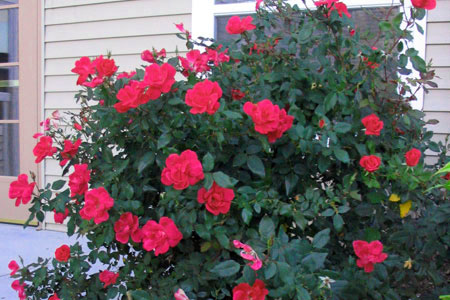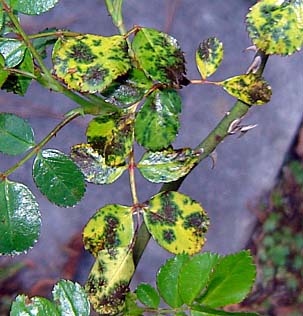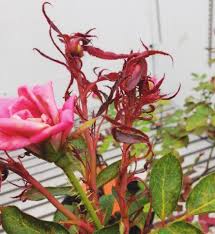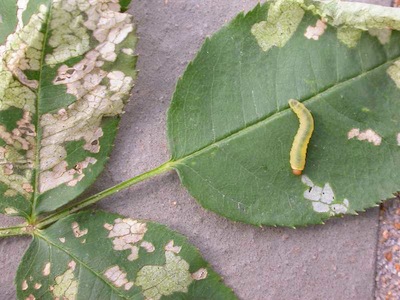Another Rose by Any Other Name
Part 2: A Few Tips on Raising Healthy Roses and Dealing with Diseases and Pests
By Janet Scheren, Fairfax Master Gardener Intern
Rose care is easier than you may think. If you can grow flowers, you can grow roses with a few caveats. Start with those that have good disease resistance and plant them in a sunny location with good drainage and air circulation. You’ll also need to water them deeply to encourage good root development and apply fertilizer three times a year. That’s pretty much it. Yes, there are some pest and diseases to watch out for, but with modest care, these issues can be kept at bay.

Shrub Rose
There are two ways to buy roses — potted/bagged or dormant bare root plants. While it’s still best to plant in the spring or fall, with the exception of extreme weather, potted roses can be planted almost any time of year and are easy to get established. Bare root roses are planted in early spring when daytime temperatures are between 40 and 60 degrees and require extra care in planting. The advantage of bare root roses is that you can order a wider variety of roses than you can find at local garden centers, and it’s less expensive to ship bare roots than potted plants.
Planting and Maintenance
Pick a well-draining site without root competition from shrubs or trees that has at least six hours of sun, preferably morning sun. This helps to dry any morning dew that can contribute to fungal disease. Prepare your bed in advance. Roses thrive in light soil amended with good organic material, such as compost, leaf mold, peat moss or aged manure. Perlite can be added to increase drainage in heavy soils. Roses grow best with a soil pH between 6.5 and 7.0. If you haven’t had your soil tested within the past three years, tests are available from your local extension office as well as many garden centers. Additional amendments may be needed if the pH falls outside this range. These will be indicated on your test results.
The planting hole should be twice as large as the root ball and deep enough for the crown to sit at soil level. Water the new bush in to help eliminate any air bubbles created when you backfill the soil.
While roses require good drainage and don’t like wet feet, they do need uniform watering. During the growing season 1 inch per week is recommended with 2 inches per week in the hottest months of the year. This should preferably be applied via a slow drip at the root zone so it can soak in deeply. Deep watering promotes a deep root system, which helps the rose survive during droughts. Frequent, light watering causes roots to form too near the soil surface, making the plant more susceptible to baking in hot summer soil. Water in the early morning as much as possible so that roses are well hydrated before facing mid-day sun. If roses do not get enough water, they will wilt, drop leaves, grow smaller leaves or stop blooming. If they receive too much water, bottom leaves will become limp, turn yellow and fall off.
Roses are considered heavy feeders, performing best with the application of a good organic fertilizer three times a year: mid-April, mid-June and mid-August. Organic fertilizers include aged manure, compost, fish emulsion, leaf mold, kelp and a wide variety of organic fertilizers formulated specifically for roses. Always water well before and after feeding. Do not fertilize in the fall as it will promote new growth that will be particularly susceptible to winter damage.
A final spring maintenance requirement is pruning. This helps maintain the health and vigor of rose bushes and ensure lots of blooms. Rose bushes are typically pruned back by about one-third of their height each spring, and any dead, damaged or diseased canes are removed and destroyed. You will also want to remove any small-diameter, twiggy growth so that strong healthy canes can support the weight of the roses. It’s important to use sharp, clean by-pass pruning shears. Each cut should be made on an angle about one-fourth inch above a live bud eye.
Diseases and Pests
Fungal diseases thrive in wet conditions and are an issue for many rose varieties in the mid-Atlantic area. To avoid fungal disease, ensure good air circulation around roses, water in the morning and remove any diseased leaves or blooms and throw them in the trash. Additionally, many newer rose cultivars are bred for excellent disease resistance. Grower websites or plant tags at nurseries often indicate varieties that are more resistant to fungal diseases. These disease-resistant roses often require treatment with sprays or systemic fungicides, but many are organic and less damaging to the environment. For a list of disease resistant roses, see the link below from the Arlington Rose Foundation.

Black Spot
Botrytis, which can occur in extremely cool, damp weather, causes buds to ball, rot and drop off. Downy mildew is another high moisture disease, which manifests with purple to red/brown irregular spots on leaves. The PMG recommends Halt Systemic Fungicide containing thiophanate-methyl for treating Botrytsis blight, and a Monterey Aliette, a Fosetyl-Al compound, for treating Downy mildew. See Chapter 4, Home Ornamentals: Control of Ornamental Diseases.

Rose Rosette
Roses are also susceptible to damage from insects. Aphids, those small green soft-bodied insects often seen on new growth, can be washed away with a spray of water from a garden hose or with insecticidal soap. They can also be controlled by beneficial insects — most notably ladybugs. If the populations of aphids are large, you might consider using a pesticide such as Bifenthrin, Imidacloprid, Permethrin, Carbaryl, Neem Oil or Insecticidal Soap, among others. Be careful not to spray roses (or other plants) when they are flowering or when bees and pollinators are active. This would kill the aphids as well as the pollinators and any beneficial insects.
Spider mites are another pest that can be controlled with the forceful spray of a garden hose. These pests suck juices from the leaves, which then turn brown and drop off. Spider mites are almost too small to see, unless you shake some of these minute red specs off the leaves onto a white sheet of paper. These can be controlled with Neem Oil, Insecticidal soap, Dormant Oil, Soybean Oil or Sulphur.

Rose slug
Another annoyance is the Japanese beetle, which emerges from grubs in the soil each summer. A small infestation can best be controlled by handpicking and dropping them in soapy water. They can also be kept to a minimum by treating your yard and garden each spring with milky spore for grubs. There are also a number of pesticide controls, such as Acetamiprid, Bifenthrin, Malathion, and Imidacloprid, but these will also kill beneficial insects and must be used with care to protect them. Be sure to follow product labels. Most will indicate that it should not be used when flowers are in bloom.
Cucumber beetles are small yellow and brown bugs that can introduce bacterial wilt and mosaic viruses that are fatal to roses. They can be controlled with methoxychlor 50 WP (Mariate).
Rose cane borers burrow deep into stem tissue causing the infested stem to die back. Some of the borers are small wasps whose caterpillars eat aphids and do minor damage. These borers can be controlled by sealing any pruning cuts with water-insoluble glue or nail polish to prevent the entry of the insect to lay eggs.
Resources
Disease Resistant Roses, Arlington Rose Foundation
A Rose Primmer, Arlington Rose Foundation
Pest Management Guide: Home Grounds & Animals 2020, Virginia Cooperative Extension
Pests and Pesticides, Arlington Rose Foundation
A Guide to Rose Diseases and Their Management, American Rose Society
Rose Rosette Disease, Publication 450-620, Virginia Cooperative Extension
Growing Roses, Factsheet | HGIC 1172, Clemson Cooperative Extension
Growing and Caring for Roses, Arizona Cooperative Extension
Rose Cane Borer, 1463, Colorado State University Extension
Rose Slugs – Shrubs, Home & Garden Information Center, University of Maryland Extension